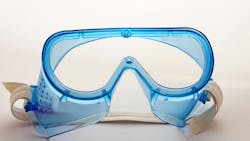A general tip for safely using solvents is to try to reduce the severity of the effects by reducing the time of exposure, the amount you’re exposed to, and the concentration of what you are using.
Another general tip is to select the mildest solvent suitable for the job. For example, household vinegar is acetic acid diluted to 5%. You could choose a 20% dilution “commercial use” version, but it’s four times as strong. Another example is you could use hydrochloric acid or muriatic acid, the latter being diluted hydrochloric acid.
- Protect your skin from solvents. Solvents can enter your blood stream through skin contact or even cause severe damage to your skin. You can reduce or eliminate skin contact by wearing gloves and other PPE suitable for protection against that solvent.
- Protect your eyes from solvents by wearing goggles (or at least safety glasses with side shields), avoiding splashing, and keeping the work literally at arm’s length.
- Protect your lungs from solvents by following the ventilation requirements in addition to these two general tips:
- Wear the PPE identified on the label and/or in the MDS. For solvents, this will not be a dust mask (e.g., N95). It will be a canister mask at the very least.
- Check to ensure it fits with no leaks. To do that, cover the canister vents with your hands and inhale. If the mask does not draw to your face and stay there, you have a leak. Which is not good for your lungs, if you use that solvent.
Before using a solvent:
- Estimate how much you will need, and put that into a small container (preferably one with a lid). Use that, not the larger container, to do your task.
- Make a note of where the emergency showers and eye washes are relative to your work area.
- Identify the approved means for cleaning up any spilled solvent and for disposing of unused solvent.
When you’re using a solvent, keep your hands away from your forehead (solvent deposited there can easily migrate to your eyes), eyes, mouth, and nose. This may take some conscious discipline because the average person touches their eyes, mouth, or nose four times per minute.
When you’re done using a solvent, don’t dump the unused portion back into the main container; while not a safety issue per se, this could contaminate the solvent. The safety issue is you need to dispose of it per the approved means you identified before using it.
About the Author

Mark Lamendola
Mark is an expert in maintenance management, having racked up an impressive track record during his time working in the field. He also has extensive knowledge of, and practical expertise with, the National Electrical Code (NEC). Through his consulting business, he provides articles and training materials on electrical topics, specializing in making difficult subjects easy to understand and focusing on the practical aspects of electrical work.
Prior to starting his own business, Mark served as the Technical Editor on EC&M for six years, worked three years in nuclear maintenance, six years as a contract project engineer/project manager, three years as a systems engineer, and three years in plant maintenance management.
Mark earned an AAS degree from Rock Valley College, a BSEET from Columbia Pacific University, and an MBA from Lake Erie College. He’s also completed several related certifications over the years and even was formerly licensed as a Master Electrician. He is a Senior Member of the IEEE and past Chairman of the Kansas City Chapters of both the IEEE and the IEEE Computer Society. Mark also served as the program director for, a board member of, and webmaster of, the Midwest Chapter of the 7x24 Exchange. He has also held memberships with the following organizations: NETA, NFPA, International Association of Webmasters, and Institute of Certified Professional Managers.
